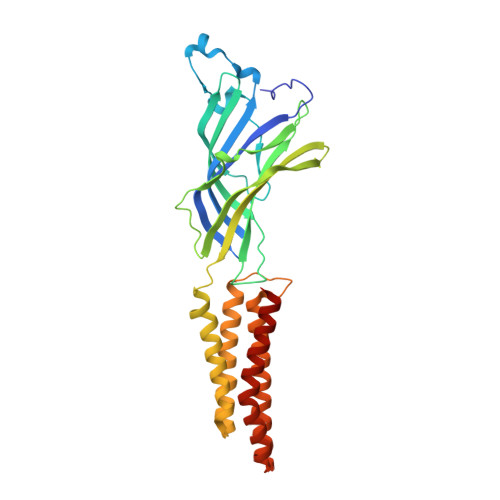Full mutational mapping of titratable residues helps to identify proton-sensors involved in the control of channel gating in the Gloeobacter violaceus pentameric ligand-gated ion channel.
Nemecz, A., Hu, H., Fourati, Z., Van Renterghem, C., Delarue, M., Corringer, P.J.(2017) PLoS Biol 15: e2004470-e2004470
- PubMed: 29281623
- DOI: https://doi.org/10.1371/journal.pbio.2004470
- Primary Citation of Related Structures:
6F0I, 6F0J, 6F0M, 6F0N, 6F0R, 6F0U, 6F0V, 6F0Z, 6F10, 6F11, 6F12, 6F13, 6F15, 6F16 - PubMed Abstract:
The Gloeobacter violaceus ligand-gated ion channel (GLIC) has been extensively studied by X-ray crystallography and other biophysical techniques. This provided key insights into the general gating mechanism of pentameric ligand-gated ion channel (pLGIC) signal transduction. However, the GLIC is activated by lowering the pH and the location of its putative proton activation site(s) still remain(s) unknown. To this end, every Asp, Glu, and His residue was mutated individually or in combination and investigated by electrophysiology. In addition to the mutational analysis, key mutations were structurally resolved to address whether particular residues contribute to proton sensing, or alternatively to GLIC-gating, independently of the side chain protonation. The data show that multiple residues located below the orthosteric site, notably E26, D32, E35, and D122 in the lower part of the extracellular domain (ECD), along with E222, H235, E243, and H277 in the transmembrane domain (TMD), alter GLIC activation. D122 and H235 were found to also alter GLIC expression. E35 is identified as a key proton-sensing residue, whereby neutralization of its side chain carboxylate stabilizes the active state. Thus, proton activation occurs allosterically to the orthosteric site, at the level of multiple loci with a key contribution of the coupling interface between the ECD and TMD.
- Unité Récepteurs-Canaux, Unité Mixte de Recherche 3571 du Centre National de la Recherche Scientifique, Institut Pasteur, Paris, France.
Organizational Affiliation:





















